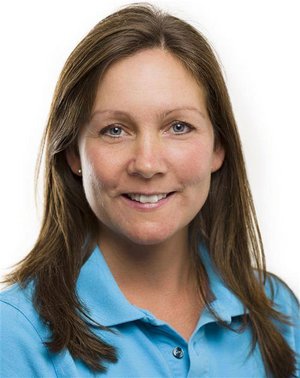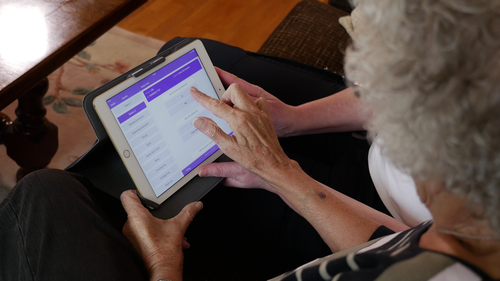Ipads Bring Added Value to ASIH Nurses & Patients
When private healthcare provider Praktikertjänst N.Ä.R.A. AB was putting together a new specialist home care (ASIH) team in Täby, just north of Stockholm, they knew that they wanted to modernise their work processes, but weren’t nearly as sure just how to go about it. Ultimately, they decided that the first step was to hire nurses who were willing to try new, digitised work routines.

Linda Vogt, Nurse, Praktikertjänst N.Ä.R.A.
Linda Vogt was one of the nurses who applied to join the new team in Täby. Apart from the independent nature of the work, Linda was enticed to apply by the chance to try out new technology and alternative solutions that moved beyond traditional work routines. Since coming on board, Linda and colleague Liselotte Dahlberg have worked actively to drive the digitisation process forward.
“All 12 nurses who joined the project did so with an open mind and a desire to work with modern technology. In connection with this futuristic approach, I was introduced to the opportunity to use an iPad for documentation work and discovered that it suited our purposes perfectly,” says Linda.
The Right Questions Create More Time for What’s Most Important
Nowadays, the ASIH team uses iPads equipped with the SwipeCare IT platform during patient visits. SwipeCare’s ready-to-use templates were designed by Linda and her colleagues and are intended to gather the information they need to collect during home visits concerning things like the patient’s well-being, nutrition, pain and more. To save time, the questions are designed with as few free-text response options as possible.
“Asking open-ended questions can easily rob you of time, both during your contact with the patient and during the post-visit work of processing the information. Now, patients are asked a specific question and can quickly and easily select one of the pre-defined answers. This leaves more time for the more important – and more satisfying – part of what we do: finding out what the patient needs help with on that particular day,” Linda explains.
Linda and her colleagues used trial and error in designing the questions and templates in order to figure out what works and what doesn’t. The templates were then evaluated and gradually adjusted to suit the ASIH team’s wishes through a running dialogue with developer Strikersoft.
“More than just streamlining the work flow, the app has also made healthcare safer. The checklists make data collection more structured and mean that we no longer risk missing questions. All the information is then stored in the one place, so we don’t need to go looking for it among different folders and systems when we want to read up on a patient at a later date,” Linda explains.
Added Value for Both Nurse and Patient
Linda and her team have come a long way in the digitisation process and now view the technology as a natural part of their work. They don’t share the concern voiced by many nurses who have yet to try eHealth technology that digitisation will replace human contact. On the contrary, in their experience, the technology supports more “humanised” contact, eliminating the need for a large computer monitor between themselves and the patient, who also has the chance to experience the new technology for themselves.
“The patients start out at very different levels in their ability to use the iPad, depending on how familiar they are with technological gadgets, but they learn quickly! The other week I visited a 90-year-old patient who had never seen an iPad before. It didn’t take long before he got curious and felt confident enough to answer the questions on his own, though,” says Linda.
The new eHealth practice allows patients to be involved in their care in a whole new way. In Linda’s experience, choosing their own responses to the questions displayed on the iPad makes patients both calmer and more active in managing their own well-being. She explains:
“The patients become more aware of what they’re eating, how they feel and trends in their own health. In the beginning, I mostly thought about the new work method from the nurse’s perspective – that it would make our work easier. Still, it wasn’t long before I realised the value it adds for the patient too. In part because we have more time to spend with them, but also because they’re made to feel like active participants in their own care."

Technology Opens New Doors
Linda and her colleagues in Täby’s ASIH team have come a long way in their use of SwipeCare. She proudly relates how Praktikertjänst N.Ä.R.A. received a prize for innovation in eHealth at an event held by Praktikertjänst. Still, the team isn’t content to rest on its laurels:
“What we’d really like is to have the information we collect via SwipeCare transferred directly to the patient journal system. Initially this was not possible, but now we have this integration established,” Linda explains. “So now, with the simple touch of a button, the text goes directly in a patient’s journal.”
The roll-out is now going into the next phase where Linda is educating the other 11 ASIH teams in the Stockholm region to work more patient centric with SwipeCare. In the meantime, Linda and her colleagues continue to work on developing and improving their templates.
“At the moment we’re designing new types of templates for initial visits during which patients’ basic data are registered for the first time. We’ve even managed to get our anatomical pain chart loaded into the iPad. On the other hand, we still have many plans that haven’t been realised yet and even more ideas still floating around inside our heads. One idea that I came up with was the anatomical lesion chart – a new way to document sores – which is in the process of becoming a template. It’s really exciting!” she exclaims.
***
Linda’s top tips for working more patient-centric with SwipeCare:
1. It’s a process that takes time. You need a lot of patience – it’s often one step forward and two steps backwards – but when you start seeing real results, the feeling is amazing!
2. Make sure you have a good team working on the project. Both I and my colleague Liselotte have found that it’s easier to drive the change process forward when you have two people working on it together.
3. Make sure to give timely feedback to help keep the project moving forward. When we come across things that could work better, we report them. Strikersoft is then quick to either solve the problem or to implement our request, as the case may be. The changes need to be made quickly, however. Otherwise, it’s easy to lose the motivation to go on.
Read more about eHealth HERE





